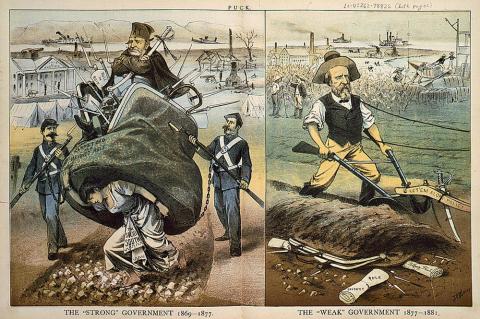
Description
In this two-part cartoon from 1880, "The Solid South" is seen struggling under the "Carpet Bag and Bayonet Rule" of the "Strong" United States government, led by President Ulysses S. Grant, who is seen riding among bayonets with an escort of two federal soldiers. In the background, the illustration shows a destroyed and occupied South. On the other hand, under the Presidency of Rutherford B. Hayes, the "Carpet Bag and Bayonet Rule" is being plowed under by the president's "Let’em Alone Policy." Under this "Weak" government, the New South is depicted and factories and fields thrive in the background. A white man, presumably a land owner, is drawn giving orders to an African-American, presumably a sharecropper or tenant farmer. The cartoon shows the dichotomy of the two presidencies. Republican Civil War hero Ulysses S. Grant used the powers of the 1870 and 1871 Enforcement Acts to send federal troops into the South to protect the civil and voting rights of African Americans when he became president. He also ordered the Justice Department to increase their efforts to identify, arrest and prosecute members of violent white mobs, including the Ku Klux Klan. Republican Rutherford B. Hayes placated Democratic leaders in Congress by agreeing to create what would become known as the Compromise of 1877. In exchange for conceding the presidency to Hayes, he would withdraw the remaining federal troops from the South whose support were essential for the survival of Republican state governments in Florida, Louisiana and South Carolina. Hayes followed through only a few months into his presidency, and as a result, the remaining southern state Republican governments collapsed, southern Democrats regained control of southern politics and forced out African Americans and carpetbaggers, new state constitutions were written and laws passed and the gains made for African American civil and political rights were crushed.
Transcript of "The 'Strong' Government 1869-1877 -- The 'Weak' Government 1877-1881"
Source-Dependent Questions
- According to the artist, what was the difference between Presidents Ulysses S. Grant and Rutherford B. Hayes in how they dealt with the South during and immediately after Reconstruction?
- Which government, "Strong" or "Weak," was most beneficial to the southern states and their people according to the artist? How did the artist draw these images to prove this point?
- How would Hayes' non-interventionist policies have impacted both the makeup of Southern governments and the civil and political rights gained by African Americans during Reconstruction?
Citation Information
Wales, James A., "The 'Strong' government 1869-1877 -- The 'weak' government 1877-1881 / J.A. Wales," 1880. Courtesy of Library of Congress